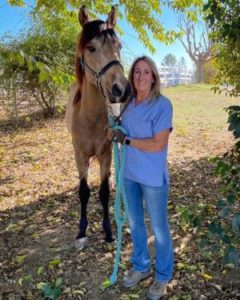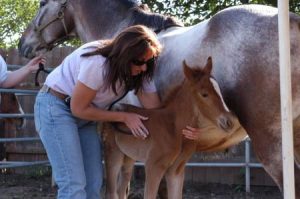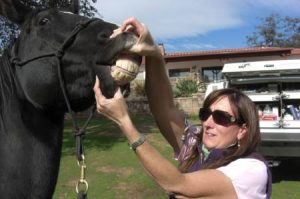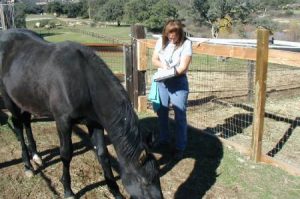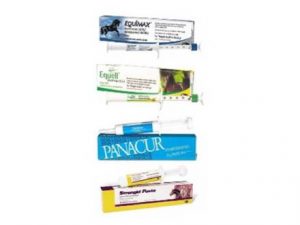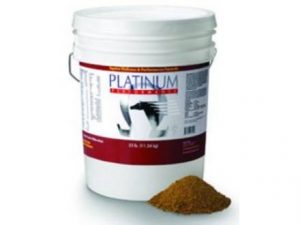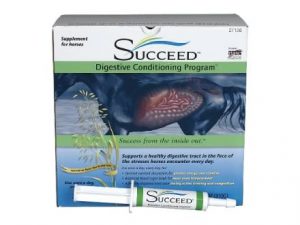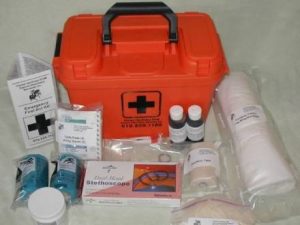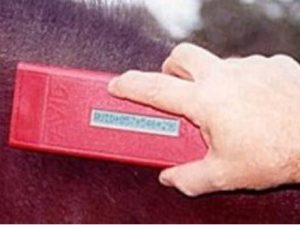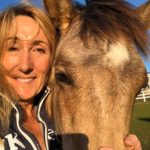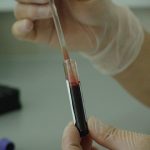Horses are "post-gastric fermenters." This means a large portion of the horse's digestion comes from the fermentation of fiber within the latter portions of the digestive system.
Surprising little digestion goes on in the stomach itself. There is a small microbial population which initiates some fermentation, and there is also some enzymatic action--but food remains in the stomach only 15 minutes before being pushed on to the small intestine, with little time for any major food breakdown. When the stomach reaches about two-thirds of its capacity, it typically starts to pass food on to the small intestine. Then the ingestion of additional food causes the process to continue into the cecum and large intestine. As long as the horse keeps eating, food continues to be pushed through the system. The large intestine produces over 60% of the horse's energy.
Hay generally falls into one of two categories -- grasses or legumes. Horse hay is often a mixture of the two. What is readily available and most cost effective generally depends on the part of the country in which you live.
Hay’s nutritive value and palatability (i.e. how much your horse enjoys eating it) will depend on a number of factors, such as:
- Plant Species
- Level of Plant Maturity at Harvest
- Weed Content
- Growing Conditions (rain, weather, insects, disease)
- Curing & Harvesting Conditions
- Soil Conditions and Fertility
- Moisture Content
- Length & Method of Storage
Alfalfa and clover are examples of legumes. Alfalfa is more commonly fed as hay than is clover, although clover may be a component of a mixed hay.
Legumes tend to be higher in protein, energy, calcium and vitamin A than grass hays. This concentrated source of energy and protein may be an advantage when fed as part of the ration for young, growing horses, lactating mares, and performance athletes.
However, not all horses need the rich levels of nutrients present in premium alfalfa. By buying a lower quality hay (such as an early cutting or one harvested in a late stage of plant maturity), or by selecting an alfalfa grass mix hay, you can get alfalfa’s dietary benefits without supplying excess nutrients that may predispose young horses to problems such as developmental bone disease and epiphysitis.
When feeding alfalfa, there is also a need to include a palatable, high phosphorous mineral supplement as part of the ration. Doing so will bring the calcium/ phosphorous ratio into a better balance for the horse. This is especially important when feeding young, growing horses. High phosphorous supplements are commercially available just for this reason.
Due to alfalfa’s high mineral content, your horse will likely drink more water when being fed this legume. In turn, your horse’s stall will be wetter and require more care to keep it clean, dry and ammonia-free.
Although grass hay is generally lower in protein and energy, and higher in fiber than legume hay, this is, in part, what makes it a good choice for many adult horses. It can satisfy the horse’s appetite and provide necessary roughage without excess calories and protein.
A good quality grass hay may meet most of the adult horse’s basic nutritional needs. Mature horses require 10% - 12% CP (crude protein) in their diets. Many native or prairie grass hays contain just 6-8 percent. A fortified grain concentrate can be used to supplement the ration, increasing its energy, protein, vitamin and mineral content.
Common varieties of grass used for horse hay include:
- Timothy
- Orchard
- Brome
- Fescue
- Prairie or Wild Native
- Oat
- Bermuda
A horse’s protein and energy requirements will depend on age, stage of development, metabolism and workload. Choosing hay and incorporating it into the ration should be done with the individual’s needs in mind.
Hay alone may not meet the total dietary requirements of young, growing horses or those used for high levels of performance. However, high quality hay may supply ample nutrition for less active adult horses.
A mature horse will eat 2 to 2.5% of its body weight a day. For optimum health, nutritionists recommend that at least half of this should be roughage such as hay. For a 1000 pound horse, that means at least 10 pounds of hay each day.
Most people buy hay based on how it looks, smells and feels. These are "qualitative" factors, and they are important. When appraising hay, keep in mind the following points:
It’s what’s inside that counts. Ask that one or several bales be opened so you can evaluate the hay inside the bales. (Do not worry about slight discoloration on the outside, especially in stacked hay).
- Choose hay that is as fine-stemmed, green and leafy as possible, and is soft to the touch.
- Avoid hay that is overcured, excessively sun-bleached, or smells moldy, musty, dusty or fermented.
- Examine the leaves, stems and flowers or seed pods to determine the level of maturity.
- Select hay that has been harvested when the plants are in early bloom (for legumes) or before seed heads have formed in grasses.
- Avoid hay that contains significant amounts of weeds, dirt, trash or debris.
- Examine hay for signs of insect infestation or disease. Be especially careful to check for blister beetles in alfalfa. Ask the grower about any potential problems in the region.
- Reject bales that seem excessively heavy for their size or feel warm to the touch. (They may contain excess moisture that could cause mold, or worse, spontaneous combustion.)
- When possible, purchase and feed hay within a year of harvest to preserve its nutritional value.
- Store hay in a dry, sheltered area out of the rain, snow and sun, or cover in the stack to protect it from the elements.
- When buying in quantity, have the hay analyzed by a certified forage laboratory to determine its actual nutrient content.
No matter how good hay might look, only through chemical analysis can its actual nutrient value be determined. To test the hay, core samples are taken from a number of bales within a stack and combined. The forage laboratory then determines the following by percentage:
- Dry Matter (DM)
- Crude Protein (CP)
- Crude Fiber (CF)
- Minerals including calcium, phosphorous, potassium, magnesium
Crude protein (CP) and Crude Fiber (CF) are key to assessing the hay’s nutritional value. Some labs will break the fiber down into two components -- acid detergent fiber (ADF) and neutral detergent fiber (NDF) -- to better estimate its digestibility.
The forage lab might also recommend testing for other vitamins and minerals. This is a good idea, especially if you live in an area with known deficiencies or toxicities.

